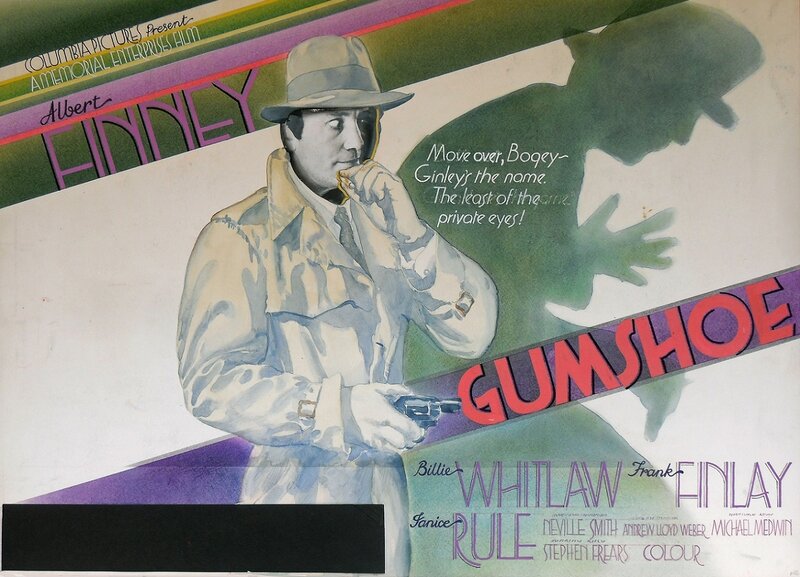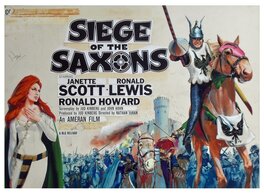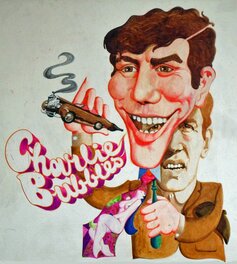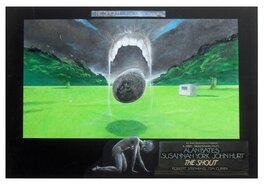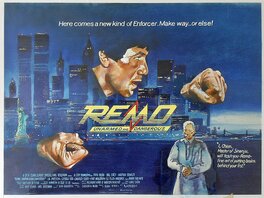In Doyle 's collection
Description
Vic Fair's prototype artwork for GUMSHOE (1971). One of my all-time-favourite Movie Poster designs by the artist, so I was especially pleased to see the prototype painting come up for sale. Another instance where the prototype design is very close to the printed version. Albert Finney's face on both the prototype and finished artwork is a pasted-up photographic image.
GUMSHOE is a 1971 film and was the directorial debut of British director Stephen Frears. Written by local author Neville Smith, who appears as Arthur, the film is set in Liverpool with Albert Finney playing the role of Eddie Ginley. Ginley is a bingo-caller and occasional club comedian who dreams of being a private eye of the kind he knows from films and pulp novels. Having put an advertisement in a local newspaper (the Liverpool Echo) as a birthday present to himself, Ginley is suddenly contacted for what appears to be an actual piece of detective work.
The film has many comic moments as it switches between detective novel and affectionate spoof. It has some shots of Liverpool buildings that have long since been demolished, including the employment exchange on Leece Street.
Gumshoe was the first of two films with original music scores by Andrew Lloyd Webber (the other was The Odessa File, in 1974). Some of the music was re-used in Lloyd Webber's musical version of Sunset Boulevard (1993).
Several scenes in the London part of the narrative take place in and around Paul Brunton's famous occult bookstore, The Atlantis Bookshop.
Despite its relatively lightweight tone, Frears' film is not without its contentious moments. TV broadcasts are nowadays rare because of Ginley's use of racist language and insults (such as calling a black African character "Mighty Joe Young" and a "spade" — see list of ethnic slurs). Another scene was significantly (and clumsily) shortened before release because of its detailed depiction of a heroin-user preparing and taking his 'fix'.
GUMSHOE is a 1971 film and was the directorial debut of British director Stephen Frears. Written by local author Neville Smith, who appears as Arthur, the film is set in Liverpool with Albert Finney playing the role of Eddie Ginley. Ginley is a bingo-caller and occasional club comedian who dreams of being a private eye of the kind he knows from films and pulp novels. Having put an advertisement in a local newspaper (the Liverpool Echo) as a birthday present to himself, Ginley is suddenly contacted for what appears to be an actual piece of detective work.
The film has many comic moments as it switches between detective novel and affectionate spoof. It has some shots of Liverpool buildings that have long since been demolished, including the employment exchange on Leece Street.
Gumshoe was the first of two films with original music scores by Andrew Lloyd Webber (the other was The Odessa File, in 1974). Some of the music was re-used in Lloyd Webber's musical version of Sunset Boulevard (1993).
Several scenes in the London part of the narrative take place in and around Paul Brunton's famous occult bookstore, The Atlantis Bookshop.
Despite its relatively lightweight tone, Frears' film is not without its contentious moments. TV broadcasts are nowadays rare because of Ginley's use of racist language and insults (such as calling a black African character "Mighty Joe Young" and a "spade" — see list of ethnic slurs). Another scene was significantly (and clumsily) shortened before release because of its detailed depiction of a heroin-user preparing and taking his 'fix'.
To leave a comment on that piece, please log in
About Vic Fair
Victor Fair was born in Chadwell Heath, Essex, on 18 March 1938. His father was an industrial designer for Ford who died when Victor was aged four. He left school aged 16 and got a job as a messenger boy for the Hector Hughes design agency and attended life drawing classes at St Martin's School of Art in the evening. After Hector Hughes he worked at the Dixons agency.
In the mid 1950s, Fair started his national service in the British Army when he served in Cyprus during the EOKA guerrilla campaign.
He could have avoided service, having previously suffered from tuberculosis and other medical conditions, but saw his enlistment as an opportunity to get away from a claustrophobic home life with his mother and sister where he was the man of the house following his father's death.[2] One of his jobs in the army was to search villages for weapons but he was more often to be found sketching the natives.

